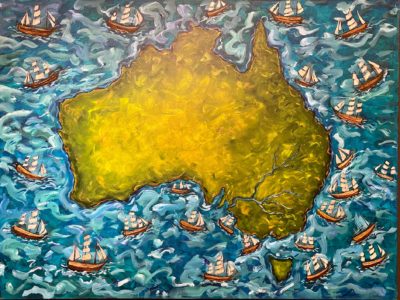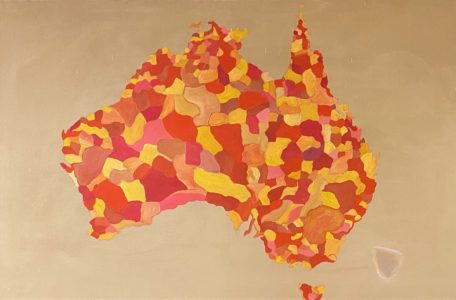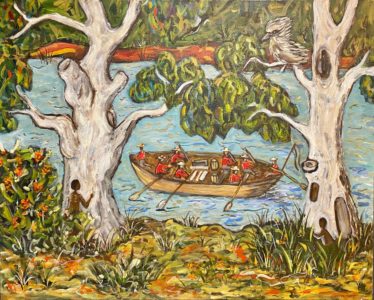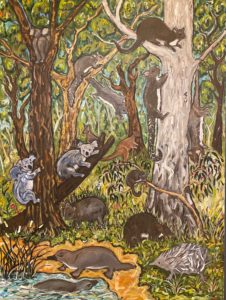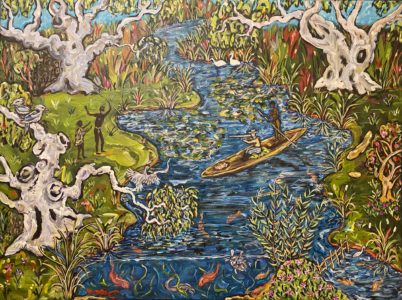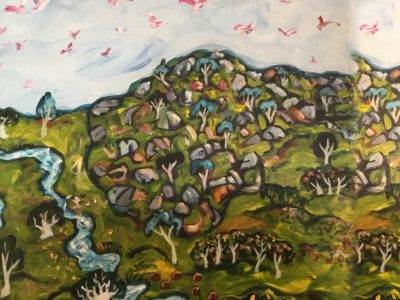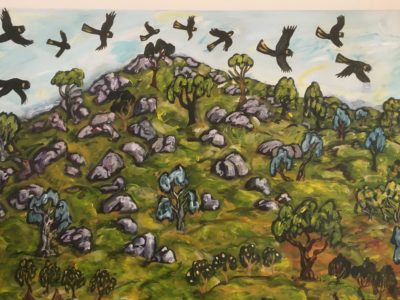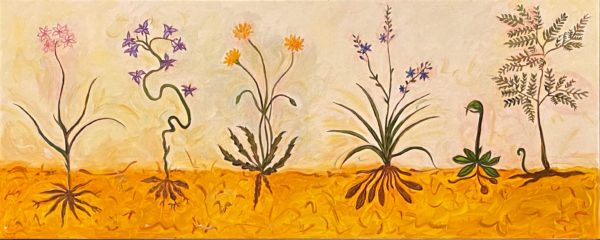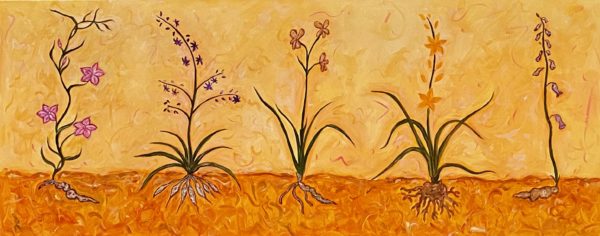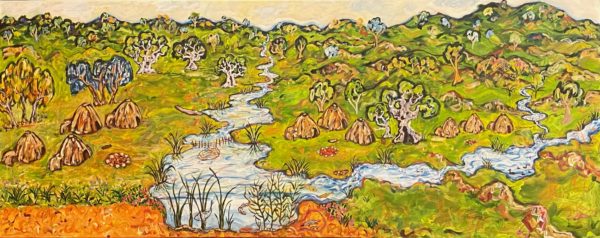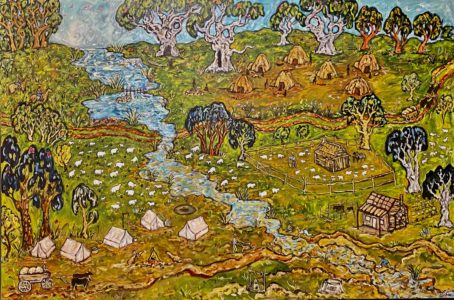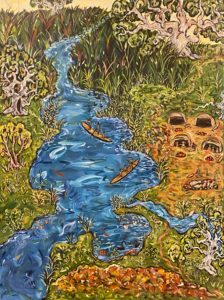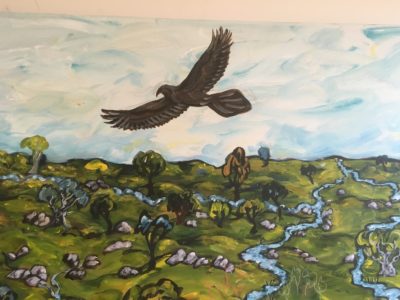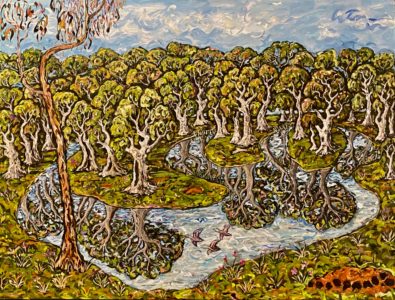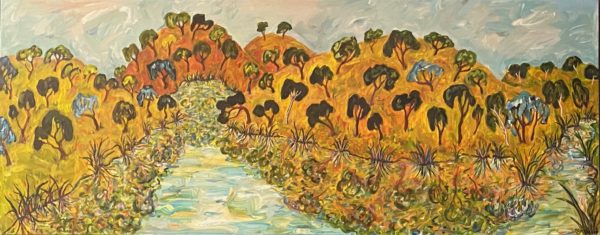Exhibition 2020
ARTS OPEN 2020 EXHIBITION
At the Frontier
Questioning the colonial meta-narrative of ‘peaceful settlement’
Fri-Mon 7-9 & 13-16 March
New Northern Arts Hotel
359 Barker st Castlemaine
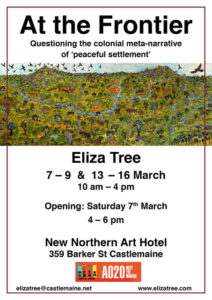
At the Frontier
Questioning the meta-narrative of ‘peaceful settlement’
This exhibition challenges the misconception that Victoria and Castlemaine began with gold! Describing instead, Indigenous cultural landscapes, rich with diverse plant foods, flora, fauna and ecosystems, – home to the Indigenous Peoples the Dja Dja Wurrung, who inhabited this region for millennia, and were so rapidly and violently displaced by disease, squatters, and fire-arms.
I focus upon the Mt Alexander/Leanganook region – Djaara country to understand our shared history, the cultural injustices and the process of environmental change. Over many years I have studied, travelled, gathered maps, references and books which have enabled me to understand this place at that time in– the Dja Dja Wurrung people’s Djaara country – more clearly and deeply.
Beginning in 1836, with the journey of Surveyor-General and explorer Major Mitchell, I follow the rapid expansion of pastoralism in Victoria and the process of ‘colonisation’, questioning the silence which hangs over the 15 years between 1836 and 1851. I reference explorers, Protectors and squatters, to reconstruct a more comprehensive picture of what occurred during “the fastest land grab in history” (James Boyce, 1835, published by Black Inc, 2011). In the 15 years before gold, most of Victoria’s best land had been ‘taken up’ by squatters and their flocks. What happened to the Aboriginal people is a terrible story, which is largely untold.
There is abundant evidence – from Mitchell’s journals and descriptions of the Australia Felix, through Protector’s Journals, et al – to re-evaluate our old perceptions and bring new understandings of the attitudes and actions of the Protectors and squatters in what is clearly “invasion and theft of Indigenous land, life and culture”.
I attempt to recontextualise the sequence of events to reveal a new narrative:
following the arrival of the First Fleet, there were two epidemics of smallpox, various explorers, government-condoned pastoral expansion and an influx of squatters and sheep, closely guarded by armed convict shepherds: a wild frontier indeed.
The devastation and mass dispossession was extraordinarily rapid. In this area,surviving Indigenous peoples were rounded up and taken to the tiny Reserve at Franklinford. Even this place was subsequently taken by the pastoralists, with the remaining population sent to Coranderrk. They were15 terrible years leading up to the Gold Rush of the 1850’s.
We must question the very language of exploration and discovery: Terra Nullius, ‘settlement’ and colonisation. There is no doubt these concepts are uncomfortable, as has been seen through the ‘History wars’. Only 175 years and 4 or 5 generations ago! The story of the Gold Rush is far more heroic and appealing.
I present this work in the hope of endgendering a more thoughtful and positive future.
Eliza Tree
Artist & Expeditioner
2020
This quote from Michael Christie describes the process succinctly :
“Pastoralism required huge stretches of land, the same land that was at the heart of Aboriginal society. The squatters’ sheep and cattle ate up the pastures on which native game fed, and demolished the yams and mirr-n’yong roots which traditionally served as a staple of the Aboriginal diet…
Around Melbourne and in rapidly settled areas, eeling spots, rivers, traditional camping places and sacred sites were fenced off, and the Aborigines forbidden entry. In the interior, waterholes that had previously provided fish, duck and eels were spoiled by sheep or closely guarded by hutkeepers.
Aboriginal campsites, chosen for the availability of water and seasonal food supplies, were taken over by squatters who were attracted to them by the same advantages… Wherever the white man went, the native game was eaten out by sheep or shot for sport.
Deprived of their former food sources, the Aborigines either starved… or obtained food in some way or other from the whites.[1]”
[1] M.F. Christie: Aborigines in Colonial Victoria 1835 – 86. p 41
